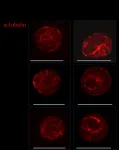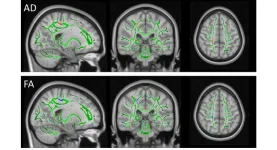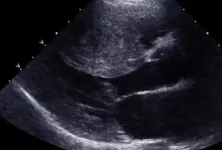(Press-News.org) Scientists at Duke-NUS Medical School have identified how the first domino falls after a person encounters an allergen, such as peanuts, shellfish, pollen or dust mites. Their discovery, published in the April issue of Nature Immunology, could herald the development of drugs to prevent these severe reactions.
It is well established that when mast cells, a type of immune cell, mistake a harmless substance, such as peanuts or dust mites, as a threat, they release an immediate first wave of bioactive chemicals against the perceived threat. When mast cells, which reside under the skin, around blood vessels and in the linings of the airways and the gastrointestinal tract, simultaneously release their pre-stored load of bioactive chemicals into the blood, instant and systemic shock can result, which can be lethal without quick intervention.
More than 10 per cent of the global population suffers from food allergies, according to the World Health Organisation (WHO). As allergy rates continue to climb, so does the incidence of food-triggered anaphylaxis and asthma worldwide. In Singapore, asthma affects one in five children while food allergies are already the leading cause of anaphylactic shock.
What the team at Duke-NUS has now discovered is that the release of particulate mast cell granules, which contain these bioactive chemicals, is controlled by two members of an intracellular multiprotein complex called inflammasome. Until now, these inflammasome proteins were only known to spontaneously assemble within immune cells to secrete soluble chemicals to alert other parts of the immune system upon detection of an infection.
Professor Soman Abraham, Grace Kerby Distinguished Professor of Pathology at Duke University, who led this research when working in Duke-NUS’ Emerging Infectious Diseases Programme, said:
“We discovered that the inflammasome components played a surprisingly crucial role in transporting particulate mast cell granules which are typically packed in the cell centre to the cell surface where they are released. This surprising discovery gives us a precise target where we can intervene to prevent the cascade of events initiated in mast cells that leads to anaphylactic shock.”
Prof Abraham and his team’s eureka moment came while observing mice[1] whose mast cells lacked either of the two inflammasome proteins, NLRP3 or ASC. When these animals were exposed to allergens, they failed to experience anaphylactic shock. However, anaphylactic shock was observed when mast cell NLRP3 and ASC proteins assembled and bound to individual intracellular granules, forming a complex the researchers call granulosome, facilitating the granules’ movement along tracks formed by the cytoskeleton within the mast cell—akin to hooking them onto a set of “rail tracks”.
Dr Pradeep Bist, co-first author of the paper and a principal research scientist with Duke-NUS’ Emerging Infectious Diseases Programme, said:
“Upon mast cell activation, we observed rapid granule movement on dynamic tracks known as microtubules to the cell membrane, where these granules were promptly released from the cell. However, in mast cells deficient in either NLRP3 or ASC proteins, we found no sign of intracellular granule movement and none of these granules were released.”
Having demonstrated the trafficking role of NLRP3 and ASC, the team then turned to known inflammasome inhibitors to test whether they could prevent this event from taking place.
Using an inflammasome-blocking drug very similar to those undergoing clinical trials for chronic inflammatory diseases, called CY-09, they administered the therapy to mice before introducing an allergen. They found that in their preclinical model, they were able to effectively prevent anaphylactic shock with this drug.
Dr Andrea Mencarelli, from the Shanghai Jiao Tong University School of Medicine’s Immune Therapy Institute, Shanghai China, and who co-first authored the paper while working at Duke-NUS’ Emerging Infectious Diseases Programme, said:
“It was noteworthy that by employing a drug that specifically blocked inflammasome protein activity, we were able to selectively block the release of mast cells’ pre-stored chemicals without impacting other potentially beneficial activities of mast cells.”
While not a cure, this could offer people living with severe allergies a new tool to prevent the onset of a potentially traumatic reaction. Currently, emergency treatments are taken in the immediate aftermath of the first symptoms developing. These treatments need to be administered within a narrow window of time to be effective and they also have severe side effects.
“I could see this bringing peace of mind to parents of children with severe food allergies when they encounter situations where they can’t be sure whether there’s an exposure risk. While we don’t want to deactivate this part of the immune system for prolonged periods, this could potentially provide short-term protection,” said Prof Abraham, whose team is now working on optimising the dosage and frequency of use of this drug to achieve the best protective effects against anaphylactic shock.
“After this, we hope to do the same for asthma and allergic skin reactions.”
Professor Patrick Tan, Senior Vice-Dean for Research at Duke-NUS, said:
“This breakthrough has tremendous translational potential and represents a paradigm shift not only for further research but more importantly by enhancing the quality of life for those at risk of severe allergic reactions. It’s a beacon of hope, especially for parents of young children who live with this constant concern.”
[1] The study was conducted according to the National Advisory Committee for Laboratory Animal Research (NACLAR) guidelines
END
Duke-NUS breakthrough discovery identifies first step in allergic reactions, paving the way for new preventative strategies
Groundbreaking research from Duke-NUS offers new hope to millions with asthma and severe food allergies, signalling a new strategy for the prevention of life-threatening reactions
2024-06-04
ELSE PRESS RELEASES FROM THIS DATE:
Researchers explore the neurobiological basis of child abuse by maltreating mothers
2024-06-04
As sad as it is, child maltreatment continues to be a prevalent global social issue. Recent studies have revealed that up to one billion children aged two to 17 experience some form of abuse or neglect every year. While it is possible that some children may eventually overcome these experiences, abundant evidence indicates that child abuse can continue to have a lasting negative impact on brain and mental development, even as these children age. Therefore, prioritizing the prevention of this menacing behavior is crucial.
One way to pursue this goal is to focus on the underlying causes that lead to the perpetuation of abuse, ...
Scientists push single-molecule DNA sequencing to the next level
2024-06-04
SAN FRANCISCO—June 4, 2024—In recent years, technologies that allow scientists to study a person’s DNA at single-molecule resolution have vastly expanded our knowledge of the human genome, the microbiome, and the genetic basis of disease. With such a detailed view of DNA, it’s possible to see genetic variants and structural details that were simply undetectable with earlier sequencing technologies.
However, today’s gold-standard methods for single-molecule analysis typically require at least 150,000 human cells—containing millions of individual DNA molecules. That means researchers can’t apply these tools when just ...
New telehealth stroke certification available to health care professionals
2024-06-04
DALLAS, June 4, 2024 — Significant barriers prevent or slow treatment for many patients with stroke, including long travel times to stroke center hospitals and the lack of availability of stroke specialists who can evaluate the patient and determine if they are a candidate for treatment.[1] Telehealth stroke care, also known as telestroke, can expand access to rural areas and other communities that face barriers to stroke care.
A new American Heart Association certification for health care professionals is designed to help standardize training and increase skills and competencies for health care providers ...
Allen Institute for Cell Science launches first disease-specific cell line collections
2024-06-04
By Jake Siegel
Seattle, WASH.—June 4, 2024—The Allen Institute for Cell Science unveiled a set of tools to accelerate research into hypertrophic cardiomyopathy (HCM), the most common genetic heart condition in the world: six new cell line collections, each carrying a different mutation associated with HCM.
HCM is primarily caused by mutations that thicken heart muscle and, in rare cases, lead to heart failure and cardiac arrest. The new cell line collections will help scientists investigate ...
Towards next-gen functional materials: direct observation of electron transfer in solids
2024-06-04
Electron transfer (ET) is a process in which an electron is transferred from one atom or molecule to another. ET is fundamental to electrochemical reactions with applications in many fields. Nanoscale ET, which involves the transfer of electrons in the range of 1–100 nanometers in solids is fundamental to the design of multifunctional materials. However, this process is not yet clearly understood.
Nanotubes, nanomaterials with unique cylindrical nanostructures, offer a variety of ET properties that can be realized through electron and hole (vacant spaces left by electrons) injections into the nanotubes, making them a suitable candidate for studying nanoscale ET. Although ...
How stress knocks out your cognitive reserve
2024-06-04
While mentally stimulating activities and life experiences can improve cognition in memory clinic patients, stress undermines this beneficial relationship. This is according to a new study from Karolinska Institutet published in Alzheimer’s & Dementia: The Journal of the Alzheimer’s Association.
Researchers in the late 1980s found that some individuals who showed no apparent symptoms of dementia during their lifetime had brain changes consistent with an advanced stage of Alzheimer’s disease. It has since been postulated that so-called ...
New study confirms presence of benzene in natural gas and potential for undetectable indoor leaks
2024-06-04
OAKLAND, CA – New research finds that even people with an average sense of smell could be living with a natural gas leak and not know it. The peer-reviewed study, published in Environmental Research Letters, finds that small gas leaks can impact indoor air quality by introducing a number of hazardous air pollutants, including the carcinogen benzene, which researchers found in 97% of natural gas samples across North America.
“While these smaller leaks are not large enough to cause gas explosions, hard-to-smell leaks are common,” ...
Allergy or infection? Scientists discover what distinguishes these two immune system responses
2024-06-04
The production of antibodies, essential for protecting our body against infections, is very well regulated through the action of a specific subtype of immune system cells, follicular helper lymphocytes. Now, a team led by Luís Graça, group leader at the Instituto de MedicinaMolecular João Lobo Antunes (iMM) and Professor at the Faculty of Medicine of the University of Lisbon, has dedicated itself to the detailed characterization of the functioning of these cells, in an article published today in the prestigious ...
Study reveals high rate of drowsy driving by teens
2024-06-04
DARIEN, IL – A new study to be presented at the SLEEP 2024 annual meeting found that drowsy driving by teenagers is a common threat to public safety on U.S. roadways.
Results of the National Sleep Foundation study show that approximately one in six adolescent drivers reported having driven drowsy. Based on these responses, the authors project that 1.7 million teenage drivers have driven drowsy, and more than 400,000 teens drive drowsy at least once per week. The majority of teens pointed to work or ...
Hypoxemia due to sleep apnea is associated with risk of lung cancer reoccurrence
2024-06-04
DARIEN, IL – A new study to be presented at the SLEEP 2024 annual meeting is the first to find that episodic hypoxemia and hypoxic burden related to obstructive sleep apnea are associated with the risk of accelerated lung cancer reoccurrence.
Results show that a 4% oxygen desaturation index of more than 15 and time spent in desaturation events were risk factors for cancer reappearance in less than two years. Measures of hypoxic burden such as time spent below 89% oxygen saturation, average oxygen saturation value below 89%, and single nadir oxygen levels, showed a similar association. After adjustment for potential confounders, average oxygen saturation below 89% and single minimum ...
LAST 30 PRESS RELEASES:
Electrodes created using light
Second-hand gift-giving is a well-deliberated decision
How human interaction drove evolution to make bears less aggressive
National Poll: Few parents offer teens guidance on healthy eating during holiday season
Cannabis derivatives could provide new ovarian cancer treatments
Raising strong yeast as a petroleum substitute
Clues to the origin of hot Jupiters hidden in their orbits
Canada’s reduced pledge to Global Fund will impact domestic health
1 in 4 children with major traumatic injuries not cared for in pediatric trauma centres
Duke and Duke-NUS’ joint cross-population research to uncover "East-West" differences in disease and care
Scientists to ‘spy’ on cancer- immune cell interactions using quantum technology breakthrough
Tech savvy users have most digital concerns
Making lighter work of calculating fluid and heat flow
Normalizing blood sugar can halve heart attack risk
Lowering blood sugar cuts heart attack risk in people with prediabetes
Study links genetic variants to risk of blinding eye disease in premature infants
Non-opioid ‘pain sponge’ therapy halts cartilage degeneration and relieves chronic pain
AI can pick up cultural values by mimicking how kids learn
China’s ecological redlines offer fast track to 30 x 30 global conservation goal
Invisible indoor threats: emerging household contaminants and their growing risks to human health
Adding antibody treatment to chemo boosts outcomes for children with rare cancer
Germline pathogenic variants among women without a history of breast cancer
Tanning beds triple melanoma risk, potentially causing broad DNA damage
Unique bond identified as key to viral infection speed
Indoor tanning makes youthful skin much older on a genetic level
Mouse model sheds new light on the causes and potential solutions to human GI problems linked to muscular dystrophy
The Journal of Nuclear Medicine ahead-of-print tip sheet: December 12, 2025
Smarter tools for peering into the microscopic world
Applications open for funding to conduct research in the Kinsey Institute archives
Global measure underestimates the severity of food insecurity
[Press-News.org] Duke-NUS breakthrough discovery identifies first step in allergic reactions, paving the way for new preventative strategiesGroundbreaking research from Duke-NUS offers new hope to millions with asthma and severe food allergies, signalling a new strategy for the prevention of life-threatening reactions







